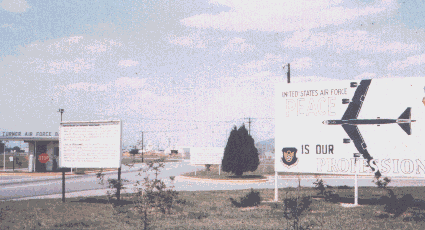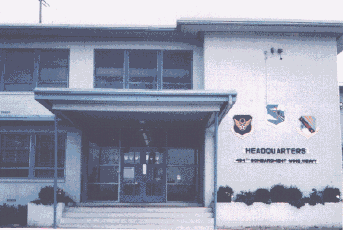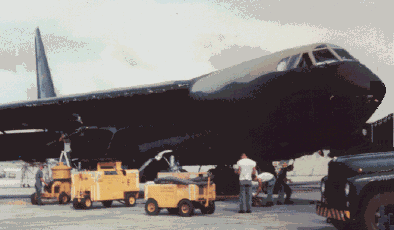| SAC Bases: Turner
Air Force Base |
|
 |
 |
| Front Gate |
450th BW
Headquarters |
|
In the late 1950s
through the mid-1960s B-52 bombers of the the 4138th Strategic Wing were
stationed at Turner Air Force Base. A
B-52D from the 484th Bomb Wing at Turner AFB crashed near Cumberland, MD
with two nuclear weapons on 13 January 1964. Strategic Air Command (SAC)
also played a prominent role in Laughlin's history. The Air Force
transferred the base to the jurisdiction of SAC on 1 April 1957. At that
time, the 4080th Strategic Reconnaissance Wing, Light, moved to Laughlin
from Turner AFB, Georgia.
In the summer of 1940, Major Peacock of the United
States Army Air Corps approached the Albany Chamber of Commerce about
the possibility of locating a new Army Air Corps training facility in
Albany. Construction under the supervision of the Army Engineers began
on 25 March 1941. After the end of hostilities, Turner Air Base was
deactivated from 15 August 1946 until 1 September 1947. With
reactivation, Turner Air Base was transferred to the Tactical Air
Commandís Ninth Air Force. On 20 November 1947, the 31st Fighter Group,
a veteran unit that had served in Europe and the Mediterranean theaters
in World War II, was stationed at Turner and became its principal
operational component. |
|

|
|
This Turner Buff is
now on display at Maxwell AFB |
Aerial refueling capability for the Wing was increased
in 1957 as the KB-50 refueling aircraft replaced the KB-29. The adoption
of the new refueling aircraft immediately caused the wing to become
non-combat ready. It began a long struggle to regain and maintain its
high degree of readiness in the new and complex equipment.
Many other Air Force units were from time to time
assigned to Turner, some temporarily and others for their life span.
Foremost of these units was SACís 40th Air Force Division which was
activated in March 1951 and inactivated on 1 April 1957. The 508th
Strategic Fighter Wing lived its life span at Turner from July 1952
until May 1956. The 408th Strategic Reconnaissance Wing, formed of
personnel of the 508th and the 4025th Strategic Reconnaissance Squadron,
which moved to Turner from a base in Ohio in May 1956 stayed until 1
April 1957. Upon the transfer of the 31st to the Ninth Air Force on that
date, the 408th was transferred to Laughlin Air Force Base, Del Rio
Texas.
On July 1, 1967, the Base was commissioned by the
Navy as the Naval Air Station, Albany. (see Naval Air Station). The
base, then known as the Naval Air Station in Albany, closed for good in
1974. For Albany, it meant a loss of at least 3,000 jobs and sent the
unemployment rate of the city soaring to 11 percent
Community leaders accepted the major challenge for
redevelopment of Turner Field, and by 1976, the first new industry
(Kroger/Tara Foods) was acquired for one of the buildings, with major
reconstruction and 80+ new jobs. This was very important, as Albany went
to school on how to deal with "Uncle Sam" in such a major redevelopment
effort. This was critical to further dealings concerning Miller Brewing
and eight or ten other transactions that led to a textbook redevelopment
effort, referred to by officials of the General Services Administration
as a classic. Many former military installations, once closed by the
Federal government have been fallow for years, and in some cases
decades. But for Albany, Miller was a major segment of the three year
period 1978-1980 that saw a virtual $3/4 billion capital expenditure for
Albany, including Miller, Delco-Remy, Procter & Gamble expansion and
several service and complimentary industries. Miller Brewing purchased
1707 acres at Turner Field from the U.S. Government for $3,300,000.
Miller built a $247 million brewery, utilizing financing available
through the Albany Dougherty Payroll Development Authority. The brewery
occupied 1.2 million square feet. Limited production began in 1980 with
the addition then of 1400 jobs, creating a total economic impact by 1980
of $10 million per year Miller Brewing is among the largest employers in
the Albany area. Its work force, ranging from brewery works and managers
to administrators and support staff, represents a diverse group of local
citizens who also make their own contributions to the community. As
parents, homeowners, taxpayers, volunteers and role models, our
employees help make Albany and southwest Georgia a thriving community.
Defense Distribution Depot Albany [DDAG], located on
one of two Marine Corps logistics bases in the world, is an important
element of the logistical efforts of the Marine Corps. The depot is the
Marine Corpsí primary source of storage and distribution of combat
vehicles, repair parts and expendables. In addition, it also provides a
full range of services to the U.S. Air Force, U.S. Army, Defense Support
Center Philadelphia, and other DLA customers. Support is also provided
to Foreign Military Sales customers and various agencies worldwide. The
depot provides wholesale distribution support for the Prepositioning
Ships Program for both the Marine Corps and the Army. The depot is
responsible for transportation management, receipt and inventory
control. Additionally, it performs the packaging, packing and
preservation function for set assembly, supports the Care of Stock in
Storage Program, and provides support to depot maintenance programs.
Resources managed include a multimillion dollar operating budget, two
million square feet of storage space, special storage for radiological
material, dehumidified storage for subsistence, and storage for textiles
and clothing for all DOD services worldwide.
Marine Corps Logistics Base-Albany divested a family
housing area near the former Turner Air Field. But base officials worked
to minimize the impact of the divestiture of Boyett Village. The
public-private venture project was initiated in 1996. Initially, the
plan was for the contractor to use the resources generated from Boyett
Village to build additional housing units adjacent to the mobile home
park on base. But the proposed agreement changed to meet the more
critical Marine Corps' housing needs at Camp Lejuene. |
|
